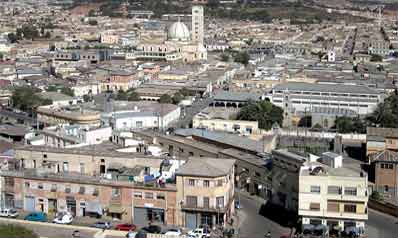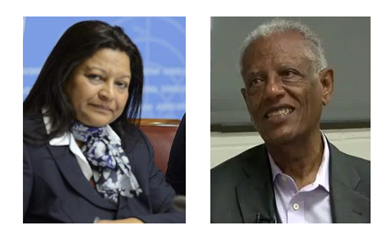Al-Diaa: No, It Wasn’t About The Curriculum

Writing for the pro-government website tesfanews.com, a certain Alamin Adam (“Wedi Hajji”) has written an article entitled “Al-Diaa School Incident and the Frenzies[sic] that Ensued” regarding the tension between community school in Asmara and government. If you were hoping to get an insight into details of the incident (never mind the events which preceded it) or the “frenzy” that followed it, you will be sorely disappointed. If, on the other hand, you are looking for the government’s favorite sport–blaming everyone else for its mistakes–this is the right article for you.
The first 10 paragraphs of the article are from the Government’s School of Preamble Writing. It is the parasite (PFDJ) wrapping itself tightly around the host (the people) by use of the constant refrain of “the people and the government”; it is stating a fact (Eritreans’s harmonious existence) without attributing the important formula for it (their insistence on respecting each other’s value systems, not ridiculing or undermining it); it is describing Eritrea’s armed struggle as a lonesome journey, when many countries and parties provided moral and material support (Egypt, Somalia, Sudan, Gulf States, the European Left); it is bragging about a catastrophic failure (in this case, the education sector of Eritrea which the UNDP tells us is ranked 179/188, ie 9th from the bottom beating out only Sierra Leone, Mozambique, South Sudan, Guinea, Burundi, Burkino Faso, Chad, Niger and Central African Republic.)
But that is not our focus, so let’s learn about incidents and “frenzies” from Alamin Adam which goes like this:
It all began with the unfortunate video clip by a clergy admittingly violating and defying laws pertaining to the educational system of the country, immediately followed by antagonizing rhetoric by the Sudanese Sheik Abdul Hay against Eritrea…
1. Clergy. 2. Admittingly [sic] violating and defying laws.
For people like Alamin Adam, the only “unfortunate” thing about the video is that there is a video. Had the Eritrean people (the host) in defiance of the government (the parasite) not videotaped it (illegally) and shared it (illegally) on social media, we would not have known about it and the government and its supporters would have been free to make up any story for making a 93-year old disappear. Not that the video clip will stop them, but at least now we can rebut them. Because we have a 3 minute video.
First of all, he is not a “clergy”. If someone is clergy because he is a “Hajji”, then the author (“Wedi Hajji”) must come from a clerical stock. Hajji Mussa Mohammed Nur is (was) president of a school board. Secondly, nowhere in the video is he admitting “violating and defying laws.” Quite the opposite: he says that he has repeatedly asked the government to show him the law that forbids the school board from running the school the way it is and, failing that, he will remain loyal to his school charter. Thirdly, notice how Alamin’s narration jumps from the Eritrean “clergy” to a Sudanese clergy with nothing in between. Nothing about the demonstration, nothing about the shots fired, nothing about the arrests that are still going on, now extended beyond Akhria to other Asmara neighborhoods.
And why is the Sudanese clergy, with his wildly inaccurate and offensive narration of Eritrean history, relevant here? If we are going to quote everybody who is me-tooing us, there are Gulf State clergy who also give sermons that the government and its supporters would love: they say it is the responsibility of every Muslim to follow his Emir (leader) without question because any disobedience is fitnah (sedition.) So, should we include that as part of the frenzy?
The author also blames AP, Martin Plaut, Al Jazeera for propagating a single-sourced (Red Sea Afar Democratic Organization) erroneous report on death and injuries from gun shots. Well, what was stopping the so-called server of the truth, Eri-TV, from dispelling it? Where were the come-and-see “reporters”? Blaming others fits the government’s agenda more because there are risks with openly speaking about it in state media.
So what exactly triggered the incident? After weeks of floating fake stories about new head scarves and Wahabi teachers, thanks to the top-down message through the Minister of Education delivered in a by-the-way interview, the troops appear to have settled on one narrative (officially): there is no consistency in curriculum between public schools and religious schools. This is how the author puts it:
The ministry of education in Eritrea doesn’t interfere in religious teaching of private religious schools, yet educational curriculum isn’t something that is left to any religious educational institute and that must be clearly understood for a good reason.
This is an area where the government has been deliberately vague on and, regretfully, the author sheds no light: what is Al-Diaa school teaching now, and what is it exactly that the government want to change it to? Like Hajji Mussa (the director), another speaker, Mohammed Abrar (now arrested) who didn’t make it to the list of the author’s “frenzies”, actually was sure that the government was on their side and its only some Ministry of Education administrators that are causing problems. The government is vague for good reason: because the “incident” has nothing to do with curriculum (as I will demonstrate below) but to ensure that the administrators of the school are hand-selected by the government and not elected/appointed by the community. If there is one thing the government and the ruling party hates, it is an independent, organized body that takes its orders from the people (its constituency) and not the government. This is, after all, a country where the entire civil society, including labor unions, youth and women’s organizations are subservient to the government and the ruling party.
Al-Diaa’s curriculum follows the government’s curriculum in all respects but one. That is: it teaches the same curriculum–syllabus, course outline, lesson plan, using the same books, trained by teachers who go through the same teacher-training courses, and the students outcomes are measured using the same proficiency exams–as its corresponding grade public schools. This applies to all private schools: whether it is Al-Diaa, or the Italian School (Scola Tilyan) that PFDJ senior officials send their children to (sorry to those who buy the “egalitarian” claims of the PFDJ elite.) The only difference is that Al-Diaa adds to the curriculum one subject that justifies its existence, its raison d’etre: quran classes. Just like an Italian school would teach Italian as a subject.
And so, when the author says, “religious private schools are found on dogmatic principles of teaching that only serve a narrow segment of the population that follow that religion”, his claim doesn’t apply to 95% of what the school does–teach secular, Ministry of Education-approved curriculum–and only to the 5%, which is Quran classes. Now, I think, even in PFDJ, where the government wants to erase all identities and replace them with one–Eritrean–the Holy Quran would appeal to Muslims and the Holy Bible to Christians.
The rights of religious institutions and religious communities are spelled out in Proclamation 73/1995 and, most recently, the 2015 Civil Code (Articles 354-356.) The government and its supporters have not made a case that Al Diaa school has violated them (which is why neither Alamin Adam nor Minister Semere Russom have cited a single clause from them) and its board believes rightfully that it is well within its rights to administer the school the way it is. Since Eritrea is ruled by men and not rule by law, the solution is: fire the board and get compliant men whose favorite two words, like that of the Mufti-in-waiting, are “yes, sir.” So, no, this has nothing to do with curriculum and everything to do with power grab.
Finally, when you have a sector that is performing as badly as it is–the Eritrean education sector–why would you go after the ones that are showing results when you have your hands full with underperforming schools, massive teacher vacancies due to exile, and anemic primary and secondary enrollment ratios due to militarization?



Awate Forum